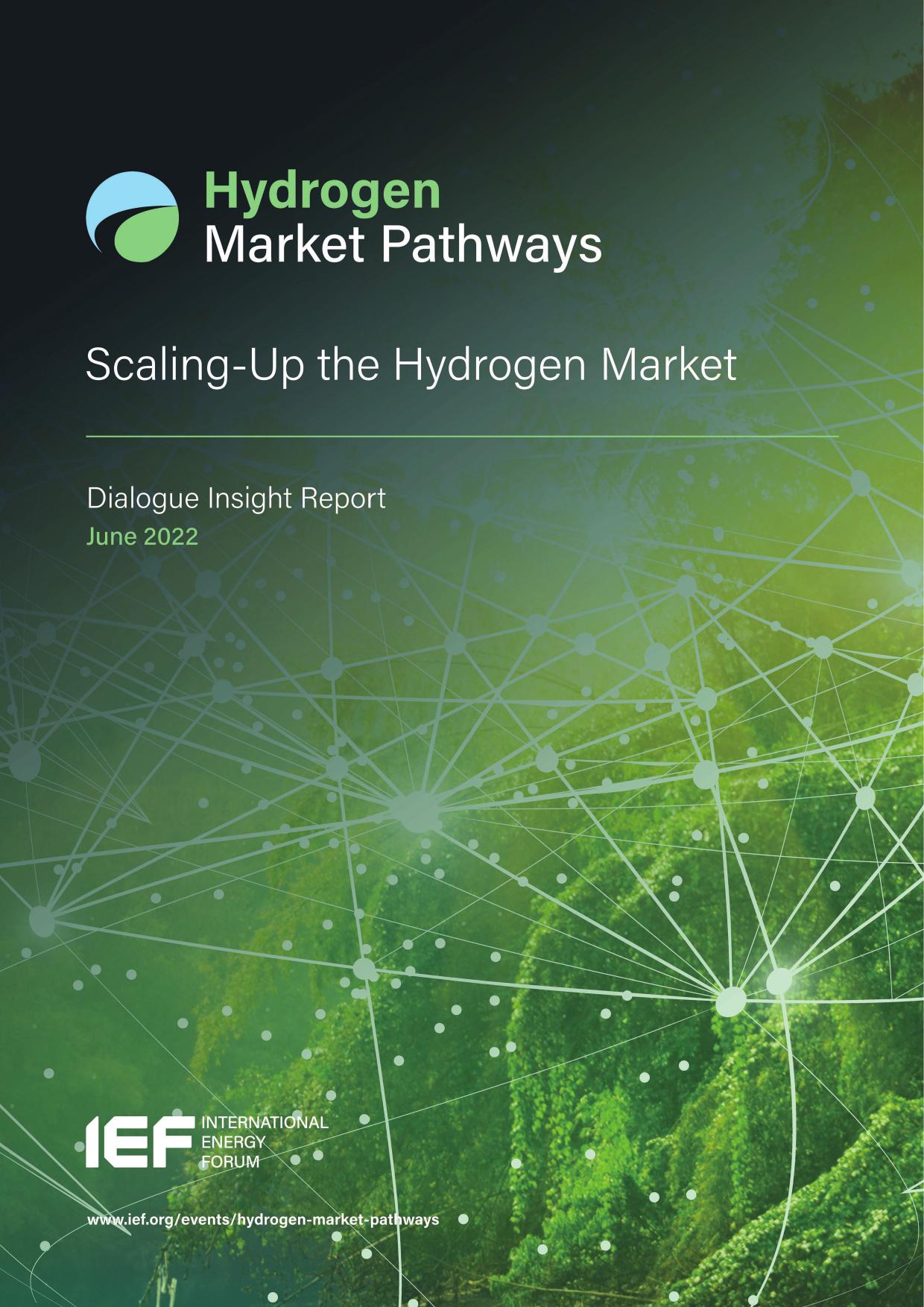AnInternationalEnergyForumreportwrittenwithAnne-SophieCorbeauJune2022Writtenandproducedby:MasonHamiltonmason.hamilton@ief.orgAllysonCutrightallyson.cutright@ief.orgAnne-SophieCorbeauac5010@columbia.eduTheInternationalEnergyForum(IEF)istheworld’slargestinternationalenergyorganizationwithmembersfrom71countriesandincludesbothproducingandconsumingnations.TheIEFhasabroadmandatetoexamineallenergyissues,includingoilandgas,cleanandrenewableenergy,sustainability,energytransitions,newtechnologies,datatransparency,andenergyaccess.ThroughtheForumanditsassociatedevents,officials,industryexecutives,andotherexpertsengageinadialogueofincreasingimportancetoglobalenergysecurityandsustainability.Anne-SophieCorbeauisaGlobalResearchScholarattheCenteronGlobalEnergyPolicyatColumbiaUniversity’sSchoolofInternationalandPublicAffairs.Herresearchfocusesonhydrogenandnaturalgas.Anne-Sophiehasover20yearsofexperienceintheenergyindustryandisarecognizedexpert.Sheistheauthorofmanypublicationsfocusingongas,LNGmarkets,Asia,China,India,andAfrica,includingthebook“LNGmarketsintransition:thegreatreconfiguration”(Oxford,2016).SheisalsoamemberoftheGastechgoverningbody._____________________________________________________________________________1TableofContentsAcknowledgments............................................................................................................................3ExecutiveSummary.........................................................................................................................4Hydrogenwillplayakeyroleindecarbonizingtheenergymix,butmassiveinvestmentanddevelopmentalongthesupplychainareneeded........................................................................6StatusQuo:ANascentandNicheMarket.......................................................................................6Demandforhydrogentotaled89Mtin2020,contributingtoonly1%oftheenergymix............7Petroleumrefiningandchemicalprocessesaccountfor96%ofhydrogendemand..................7Chinaproduces/consumes~25%ofhydrogenglobally...............................................................8Non-abatedfossilfuelscurrentlydominatehydrogenproduction...............................................8Mosthydrogenisproducedon-site..............................................................................................9Pipelinesandoverlandtransportusednow...............................................................................10Storageiscurrentlylimited.........................................................................................................10Pricingisopaque........................................................................................................................10StrengthsandOpportunities:WhyistheHydrogenMarketExpectedtoGrow?..........................11Demand–asolutionforhard-to-abatesectorsandasourceofpowersystemsflexibility.......11Hydrogencanofferflexibilityandbestored...............................................................................12Highenergydensitypermass....................................................................................................12Thehydrogeneconomygoesbeyondhydrogen.......................................................................13Lessvulnerabletogeopoliticalweaponizationcomparedtotraditionalenergysources...........13Synergywithexistingindustries.................................................................................................13WeaknessesandThreats:WhatWillLimitHydrogen’sGrowth?..................................................14Reducingthecostofhydrogen..................................................................................................14Lowenergydensitypervolume.................................................................................................15Energy-intensiveproductionandinefficientenergycarrier........................................................15Lackofexistingdedicatedinfrastructure,carboncapture,andcriticalminerals.......................17Publicacceptanceandsafety....................................................................................................18SolutionsandKeystoSuccess.....................................................................................................19Scaling-upthesupplychain.......................................................................................................19Movingfromlocalizedtoglobalmarkets....................................................................................19Low-costorstrandedenergywillhelpgrowproductionhubs....................................................20Transportationinfrastructurecrucialinmarketscale-up............................................................21_____________________________________________________________________________2Storagedevelopmentisneededtobolstersecurityofsupply...................................................21Internationalpartnerships...........................................................................................................22Datatransparencyneededforinvestorsandpolicymakers.......................................................23HydrogencanborrowfromLNGcontractstructures.................................................................23Pricedeterminationwillevolveandbecomemoretransparent.................................................24GovernmentSupportMechanisms................................................................................................25Policiesshouldsupportbutnotchoosewinners........................................................................26Conclusion:Scaling-upispartoftheproblemandthesolution....................................................27_____________________________________________________________________________3AcknowledgmentsDiscussionsheldduringtwoexpertpanelworkshopshostedbytheIEFinDecember2021andMarch2022informedthecontentofthisreport.TheauthorswouldliketothanktheIntercontinentalExchange(ICE),particularlyEgbert-JanSchutte-Hiemstra,fortheirsupportandcontributionstotheworkshopsandreport.Theauthorswouldalsoliketothanktheworkshopparticipantsfortheirengagementandfeedback,includingexpertcontributionsfromDr.KirstenWestphal(H2-Global),MarcoChiesa(SNAM),SallyPrickett(bp),JoseMBermudezMenendez(IEA),PatrickHeather(OIES),DariaNochevnik(HydrogenCouncil),RenéSchutte(HyNorth),ErikRakhou(BCG),NeilBrown(KKR),andPetervanEes(ABNAMRO)._____________________________________________________________________________4ExecutiveSummaryWhereareweheaded?•Low-carbonenergysourcesandcarrierswillneedtoreplacehigh-carbononestomeetgrowingenergydemandduringtheenergytransition.Manyenergyforecastsexpecthydrogentoplayavitalroleindecarbonizingtheenergysystem,particularlyinhard-to-abatesectorsorwhereelectrificationisimpossible,suchashigh-temperatureindustrialprocesses,heavyroadtransportation,andshipping.Hydrogenisalsoexpectedtoplayaroleasasourceofflexibilityinthepowersector.•Thecurrentenergycrisisislikelytoacceleratehydrogenmarketdevelopment.Europequadrupleditslow-carbonhydrogensupplytargetfor2030from5.6Mtpato20.6MtpaaspartofitsREPowerEUstrategytoreducerelianceonRussiannaturalgas.Over500large-scaleprojectshavebeenannouncedinthelastcoupleofyears,and>50%ofthosehavejustbeenannouncedinthepast12months.•Thehydrogenmarketwilllikelydevelopinseveralphasesandoverseveraldecadesfrom(1)localpoint-to-pointtransactionsto(2)isolated,bi-lateraltradesto(3)largercontractedinternationaldeliveriesto(4)apotentiallygloballytradedcommodity.Themarketwillmovefromlocalizedtoregionaltointernational/interconnected,butthepaceofdevelopmentwilldifferacrossregionsandsectors.•However,despiteplayingarole,hydrogenisnota‘silverbullet’forachievingdecarbonizationgoalsorenergysecurity.Inmanycases,itisthesecond-bestsolution.Directelectrificationismoreefficientinmanyapplications.Policiesandbusinessmodelsneedtotargetsupplychainsthatmakethemostsensetechnicallyandfinancially.Howdowegetthere?•Thehydrogenmarketisstillinitsinfancy,anddevelopmentisneededalongtheentiresupplychain.Low-carbonhydrogenproductionandutilizationmustincreasefrom~1milliontonsperannum(Mtpa)todaytohundredsofMtpaby2050.Marketgrowthwillinvolveexpansionanddevelopmentinproduction,transportation,storage,andend-use.Scaling-uphydrogenwillrequirenewbusinessmodels,pricing,contracts,regulations,standards,certificates,andpolicies.•Thefirstimmediatestepwillbetoreplacehydrogenmadebyunabatedfossilfuelswithlow-carbonhydrogen.ThiswillremovethechallengeofcreatingnewdemandwhilereducingCO2emissionsfromunabatedfossilfuelsinhydrogenproduction.•Hydrogen’shigh-costrelativetoitsalternativesisthemostsignificantobstacletomarketdevelopmenttoday.Costswillneedtodecreasesignificantlyduringthecomingdecade.Productionfromrenewablesiscurrentlyaround$3-8/kg(equivalentto$26-70/mmBtu,LHV).Policysupportiskeytoloweringproductioncostsandincentivizingconsumerstoswitchtohydrogen.Differenttoolswillbeatthedisposalofpolicymakers,includingcontractfordifference,productiontaxcredit,carbonpricing,andcarbonneutralitytargetsforspecificsectors.•Internationalpartnershipswillbeanessentialcomponentofdevelopingthehydrogeneconomy,providingoff-takecertainty,andenablingscale.Broad-basedcollaborationwithinandacrossindustriesandgovernmentswillbeneededaswellasacommitmentto_____________________________________________________________________________5capitalandsharingresourcesandtechnology.Inaddition,partnershipswillhelpfacilitatelong-termcontractsthatwillbekeyinscaling-up,accessingfinancing,andestablishingprovenbusinessmodels.•Hydrogendevelopmentisprimarilyameanstosupportdecarbonization.Futurehydrogenmarketsandtraderuleswillhavetoconsiderthecarbonintensityofhydrogenandanycarriersorderivatives.Thehydrogenmarketwillbebasedoncarbon-intensityandnot‘color’designations.Therefore,measuringandtrackingcarbonintensityneedstobestandardized,andcorrespondingcertificationsandguaranteesoforiginwillbeessentialelementsenablinginternationaltrade.•ThereisvalueinstudyingthedevelopmentofbusinessmodelsusedintherenewablesandLNGsectors.Lessonsfromtheevolutionofthesesectorscansupportthescale-upofhydrogenandserveasamodelfortheformationofinitiallong-termcontracts,suchasincludingmodifiedtake-or-paycommitmentstosupportprojects’CAPEXthatareadaptedtothespecificitiesofhydrogendevelopment.•Despiteparallelsbetweenhydrogenandothermarketdevelopmentpathways(suchasnaturalgas/LNG),regulationshouldnotbesystematicallyimposedinthesameway,especiallyintheearlystages.Thereisstillroomforinnovationinhydrogentechnologyandbusinessmodelsthatover-regulationcouldhinder.Regulationthatis“fitforpurpose”canhelpmitigateriskinherentinanewmarket.Providingregulatorycertaintywillbeessentialtoattractinvestmentearlyon.However,adelicatebalanceisneededtoleveragehydrogenintheenergytransitionbutalsoensurehydrogenbecomescompetitiveandcost-effective.•Energypoliciesshouldremaintechnology-neutraltoallowacceleratorsthatleveragepublicfinanceratherthancrowditout.Technology-neutralfundingwillhelpenableafastermarketlaunchandlong-termcost-efficientsupply.•Hydrogenmoleculeshaveanimportantadvantageoverelectrons,theycantransferenergyovertimeanddistancesandbestoredmoreefficiently.Hydrogencanunlockotherwisestrandedenergyassetssuchasremoteandisolatedrenewableenergysites.Itcanconnectplaceswithamplerenewableenergyresourcesbutnoeffectivemeansofdeliveringittomarketwithconcentrateddemandhubs.Infrastructureandtransportationdevelopmentswillbeneededtounlockthesearbitrageopportunities.•Hydrogenmarketdataiscurrentlylimitedandlacksstandardizeddefinitionsandconventions.Greaterdatatransparencyandstandardizationareneededtoempoweranalysts,investors,andpolicymakerstomakeinformeddecisions._____________________________________________________________________________6Introduction:Jump-StartingtheHydrogenMarketHydrogenwillplayakeyroleindecarbonizingtheenergymix,butmassiveinvestmentanddevelopmentalongthesupplychainareneededInterestandmomentumsurroundinghydrogenhasgrowninrecentyears,buttheideaofusinghydrogenasanenergycarrierisnotnew–ithascomeinandoutoffashionsincethe1970’s.Yet,despitedecadesofinterestandresearch,therearestillmanyobstaclestoovercomeforthehydrogenmarkettoscale-up.Currently,hydrogenaccountsforonly~1%oftheenergymix,ispredominatelyproducedusingunabatedfossilfuels,andismainlyusedon-sitewhereitisproduced.Forhydrogentoplayaroleintheenergytransition,itmustbeavailableinsufficientvolumes,atacompetitivecost,andwithlowcarbonintensityassociatedwithitssupplychain.Theentiresupplychainmustbedevelopedandscaled-up.Differentdemandforecastscenariosshowhydrogenconsumptiongrowingbyasmuchassix-foldby2050(withlow-carbonhydrogengrowingby500-600-fold).Suchgrowthmakesitincreasinglyplausiblethathydrogencouldbecomeaninternationallytradedcommodityinthecomingdecades.Understandingthelikelypathwaysanddriversofmaturationisessentialforreducingriskandattractinginvestorandgovernmentbuy-in.Forhydrogentoachieveitspotential,decisivepolicyactionwillbeneeded,aswellassignificantinfrastructureinvestment,todrivescale.Developinghydrogenwillrequireasignificantdevelopmentofrenewablecapacitybeyondwhatwillbeusedtodecarbonizethepowersector.Large-scalehydrogennetworkswillbenecessarytoconnectproductionandstorageresourcestoend-users.Scaling-upthesupplychaincanlowersupplycosts,increasesecurity,enablecompetitivemarkets,andfacilitateinternationaltrade.Thisreportfirstlooksatthecurrenthydrogenmarketandsupplychainandthenexamineswhatwillshapeanddeterminemarketandbusinessmodeldevelopmentundertheassumptionthateconomicsandtechnologyevolvefavorably.Next,thestudyexamineswhatexternalcontractualandregulatorysupportcanhelpguideasuccessfulscale-up.StatusQuo:ANascentandNicheMarketHydrogenisthelightestandmostabundantelementintheuniverse,butitbarelyexistsinapureformonEarth.Instead,itisabundantinchemicalcompounds,mostnotablybondedwithoxygeninwaterorcarbontoformhydrocarbonslikefossilfuels.Forthatreason,hydrogenisnotconsideredanenergysourcebutanenergycarrierorvector.Onceseparatedfromotherelements,hydrogen’sutilityincreases:itcanbeconvertedintoelectricitythroughfuelcells,itcanbecombustedtoproduceheatorpowerwithoutemittingcarbondioxide,usedasachemicalfeedstock,orasareducingagenttoreduceironorestopureironforsteelproduction._____________________________________________________________________________7Demandforhydrogentotaled89Mtin2020,contributingtoonly1%oftheenergymixHydrogendemandhasincreasedby53%overthepast20years,from58milliontons(Mt)in2000to89Mtin2020,amarketworth$150billioni.Mostofthisdemandwasforpurehydrogen(72Mt),with18Mtforhydrogenmixedwithothergassesusedinmethanolandsteelproduction.Petroleumrefiningandchemicalprocessesaccountfor96%ofhydrogendemandPetroleumrefiningaccountsforalmost~42%oftotalglobalhydrogendemand.Refiningprocessessuchashydrodesulphurization(removingsulphurfromnaturalgasandrefinedproducts),andhydrocracking(transforminglong-chainhydrocarbonsintoshorterchains)._____________________________________________________________________________8Non-fuelchemicalprocessesaccountfor~54%oftotaldemand,withthemajorityusedintheproductionoffertilizerproducts(ammonia)andmethanolproduction.Around4%ofhydrogendemandisusedintheironandsteelindustry.Asof2022,therearecurrentlynegligibleamountsofhydrogenusedinthetransportsector,withonly50,000FuelCellElectricVehicles(FCEV)intheworld,outofanestimated1.3billionglobalvehiclefleetii.Chinaproduces/consumes~25%ofhydrogengloballyChina,thelargestconsumerofhydrogeniii,usesthemoleculeinthechemicalindustrytoproduceammoniaandmethanol,andinpetroleumrefining.IntheUnitedStates,thesecond-largesthydrogenconsumer,thepetroleumrefiningindustryaccountsfortwo-thirdsofhydrogendemandandammoniaproductionaccountsfortheremainder.TheMiddleEastconsumesover10Mtofhydrogeninpetroleumrefining,chemicalproduction,andsteelproduction.Indiaconsumedover7Mtofhydrogenin2020,includingaround45%usedforrefining,35%forchemicalsandalmost20%forironandsteel.India,astheworld’slargestproducerofsteelusingtheDirectReducedIron(DRI)route,itaccountsforone-quarterofglobalDRIhydrogendemand.Non-abatedfossilfuelscurrentlydominatehydrogenproductionHydrogenproductionusesvariousmethodsandtechnologiesbutonlytwoprincipalsources,fossilfuelsandrenewablesources.Currently,>99%ofhydrogenproductioncomesfromthereformingofnaturalgas,coal,oroilproductsandproduces2.5%ofglobalenergy-relatedCO₂emissions.Naturalgas-basedhydrogenproductionrepresentsaround60%oftotalproductionandonlyamarginalamountispairedwithCarbonCaptureUtilizationandStorage(CCUS)technology.Theresultingnaturalgasconsumptionisestimatedataround240Bcm(or6%ofglobalgasdemand).Meanwhile,coalrepresents19%ofhydrogenproduction,withthemajoritylocatedinChinaandIndia._____________________________________________________________________________9Only0.2%ofglobalproductioncomesfromelectrolysis(usingelectricitytosplithydrogenfromoxygeninwater).Mosthydrogenisproducedon-siteAround85%ofhydrogeniscaptive,producedandconsumedon-site,mainlyatpetroleumrefineries.ivInlimitedoccurrences,hydrogenisproducedelsewhereandtransportedtotheconsumingsite–knownasmerchantproduction.Typically,onepetroleumrefinerywillsellexcesshydrogenproductiontoanearbypetroleumrefineryorchemicalfacility._____________________________________________________________________________10TheEUiscurrentlytheonlyregionintheworldwherehydrogenisregularlytransportedacrossnationalbordersandthisislimitedtotheNorthwestregion(Belgium,France,Germany,andtheNetherlands).Thisisdoneonabusiness-to-businessbasisandprimarilythroughadedicatedhydrogenpipelinenetwork.PipelinesandoverlandtransportusednowThebulkofmerchanthydrogeniscurrentlytransportedbypipeline.Therewas~4500kmofhydrogenpipelineintheworldasof2016,with2600kmintheUnitedStatesandaround1600kminEurope(mostlylocatedinBelgium,Germany,France,andtheNetherlands).Therestoftheworldaccountsfor340km,withabouthalfofthisinCanada.IntheUnitedStates,hydrogenpipelinesareconcentratedintheGulfCoastregionwherelargehydrogenuserssuchasrefineriesandchemicalplantsarelocatedv.Intheseregions,merchanthydrogencanmeetoverathirdoftotalhydrogendemandvi.Whentransportedoverland,hydrogenistransportedeitherbytruckorbyrailandathighpressureorinliquidform.Liquidtransportisusuallyforshortdistancesorwherethereisnopipelinesystem.Pureorelementalhydrogencanbecombinedwithotherchemicalelementstoproduce“hydrogen-basedfuels”suchassyntheticmethane,ammonia,andmethanol.Thesecanbesomewhateasiertohandleandtransportthanhydrogenandcanbeusedasfeedstockinindustrialprocesses.Although,ammoniaiswidelytraded,itismainlyforuseinfertilizermarketsandnotasahydrogenorenergycarrier.StorageiscurrentlylimitedThetechnologyofusinggeologicsaltcavernstostorehydrogenisproven;however,thereislimitedpracticalexperiencewithlarge-scalehydrogenstorage.Currently,hydrogenstorageinsaltcavernsislimitedtoonlyfouroperationalsitesintheUSandtheUKvii.Existinghydrogenstoragefacilitiesmainlyserveasbackupsuppliesforindustrialhydrogenconsumerswhenhydrogenproductionfacilitiesareundermaintenanceorexperiencedisruptions.PricingisopaqueThereisverylittletransparencyonhowhydrogenispricedtoday,andthereisalotofconfusionbetweenpriceandcosts.Mostdiscussionsarecurrentlyaroundthecurrentandfuturecostofhydrogen,nothowitwillbepricedinthefutureifafull-fledgedmarketisdeveloped.Withmosthydrogenproducedandconsumedon-siteinmanymarkets,therearefewtransactionalnormsestablishedandlimitedinformationtobeusedinpricediscoveryforaspotmarket.Itislikelythathydrogensupplywillbeinitiallypricedonacost-plusmodel.Meanwhile,thecostofhydrogenisdependentontheproductiontechnology,thecostofthefeedstock,andpower.Asmosthydrogenproductioncurrentlyusesnaturalgasasafeedstock,thepriceofhydrogenislikelytobehighlycorrelatedwiththepriceofnaturalgasinaparticularmarket.Whiletransportationandstoragearealsopartofthecurrentcostofhydrogen,thefactthatmosthydrogenisconsumedon-sitemakesitdifficulttounderstandhowthesecostsarereflectedinthepriceofmerchanthydrogen._____________________________________________________________________________11Customersareexpectedtoseeawiderangeofpricedifferencesdependingontheirgeography,deliverymethod,andquantity.Whiletheproductioncostsofhydrogenareanextremelyimportantvariableinhydrogen’smarketdevelopment,thisreportassumesthattechnologicalimprovementswilleventuallybringhydrogenproductioncostslower,notablythecostofhydrogenmadewithrenewable-poweredelectricitywhichisamagnitudehigherthanthecostofhydrogenmadefromfossilfuels(apartfromhydrogenproductionbasedonnaturalgasinEuropeorcertainAsiancountries).Therefore,thisreportdoesnotexaminehydrogenproductioncostsin-depth.StrengthsandOpportunities:WhyistheHydrogenMarketExpectedtoGrow?Demand–asolutionforhard-to-abatesectorsandasourceofpowersystemsflexibilityThecurrenthydrogenmarketisinitsinfancy,butdecarbonizationeffortswillcreategrowthopportunities.Themostattractiveapplicationsforhydrogenuptakeareinhardtoabatesectors,wheredirectelectrificationisdifficult,uneconomic,ortechnicallyunfeasible.Theseincludesteelandcementmaking,chemicals,high-temperatureheatinindustry,dispatchableelectricitygenerationbeyondafewdays,aviation,shipping,andheavy-dutytransport.Additionally,low-carbonhydrogenwillneedtoreplacehydrogenproducedfromunabatedfossilfuels,whichiscurrentlyusedinsectorssuchaspetroleumrefining,chemicalindustry,andfertilizerproduction.However,becausethesizeandscaleofhydrogenadoptionbyeachoftheseindustriescanandwillvary,hydrogendemandforecastsvarysignificantly.Asurveyofcurrentforecastsshowsagapof418Mtpabetweenthelowandhighoutlooksin2050(excludingBloombergNEF’soutlierGreenscenariowhichputshydrogendemandabove1,300Mtpain2050).Thisgapismorethan4.5timesgreaterthanthecurrentmarketsize._____________________________________________________________________________12Interestinhydrogenhasacceleratedinthepastfiveyearsasdecarbonizationtargetshavemovedtothetopofgovernmentpriorities.Morethan50countrieshavedeveloped,orareintheprocessofdeveloping,anationalhydrogenstrategy.TheEUhasquadrupleditslow-carbonhydrogensupplytargetfor2030from5.6millionmetrictonsperannum(Mtpa)to20.6Mtpa,aspartofitsREPowerEUstrategytoreducerelianceonRussiannaturalgas.Over500large-scaleprojectshavebeenannouncedinthelastcoupleofyearsand>50%ofthosehavejustbeenannouncedinthepast12months(asofApril2022).Therearemanyambitioustargets,butitisnotclearhowtheywillbeachieved.Uptakeanddemandstimulationwillbeneededtoreachthesegoalsandmarketdevelopmentprogress.HydrogencanofferflexibilityandbestoredHydrogenmoleculeshaveflexibilityandstorabilitythatcancomplementandbalanceintermittentrenewableenergysourcesviii.Unlikebatterystorage,hydrogencanbetransportedoverlongdistances,andstoredundergroundalmostindefinitelywithminimalenergycontentlossovertimeix–idealforgrid-scalelong-durationstorage.Theuseofsaltcavernstostorehydrogenisalreadyaproventechnology,whiletheuseofdepletedfieldsremainstobeproven.Ascountriesincreasetheirshareofrenewables,flexibilityrequirementswillincreaseonaweeklytoannualhorizon.Hydrogen,aswellassyntheticgas(madefromhydrogen),canplayasignificantroleinmeetinglonger-termflexibilityneedsofthepowersystem.Hydrogencanbeusedtomitigatetheseasonalvariationsofrenewableproductionagainstelectricitydemand:astheworldelectrifies,higherhydrogenproductionthroughexcessrenewableelectricityduringoneseasoncanbeusedtomeethigherelectricitydemandduringanotherseasonwhenrenewablesareinsufficienttomeetdemand.Hydrogencanbeusedtounlock“stranded”renewableenergyassets,suchasthoseinremote,off-gridlocations,withlittletonoaccesstoasuitablemarketormeansoflong-distanceelectricaltransmission.Theserenewableenergyassetscangenerateelectricitywhichisthenusedinelectrolysistoproducehydrogen.Thishydrogencanthenbestored,transported,andshippedfromtheseremotelocationstomarket.Storagewillbeparticularlyimportantinhelpinghydrogentoplayitsroleasasourceofflexibilityinpowersystems.Hydrogencanalsobestoredinlargequantitiestoserveasastrategicreservewithmultipleend-useapplications.Thiscanhelpbolsterenergysecurityandmitigateenergypricevolatilityandenergycrises.HighenergydensitypermassHydrogenhasasignificantlyhigherenergydensitypermassthananyotherenergysource.Onekilogramofhydrogencontainsasignificantamountofenergy,makingitanefficientandlightweightenergycarrier.Therefore,hydrogenisattractiveintransportapplicationswherelargeamountsofenergyarerequiredatminimalweightsuchasaviation,shipping,andlong-distancetrucking._____________________________________________________________________________13ThehydrogeneconomygoesbeyondhydrogenWhiletalkingaboutthehydrogeneconomy,itisimportanttounderstandthatthisconceptgoesbeyondpurehydrogen.Italsoincludesotherenergycarriersbasedonhydrogensuchasammonia,methanol,aswellassyntheticmethane,whichareeasiertotransport.AmmoniacouldbeusedinshippingandiscurrentlybeingtestedinJapaninthepowersectormixedwithcoal;methanolisbeingtestedinshippingbyMaerskwhilesyntheticmethanecanbeproducedfromhydrogenandcapturedCO2andthereforeusethecurrentnaturalgasinfrastructure.LessvulnerabletogeopoliticalweaponizationcomparedtotraditionalenergysourcesItistechnicallypossibletoproducelow-carbonhydrogenanywhereintheworld,basedonvariousenergysourcesrangingfromwind,solar,biomass,nuclear,hydroaswellasnaturalgas(withCCUS).Countriescanleveragehydrogentodiversifytheirenergysourcesandtradepartnersasmanycountrieswilllikelybecomehydrogenproducersandconsumers.Oncethemarkethasscaled,hydrogenislesslikelytobesuccessfullyweaponizedbyanexporternorgiveamassiveimportingcountryunduemarketpowergiventhenumberanddiversityofpotentialhydrogenexporters.Usinghydrogentoaugmenttheenergymixcanhelpensureenergysecurity.SynergywithexistingindustriesHydrogenhasmanysimilaritieswithexistingoilandgasindustriesandrenewableindustries.Theoilandgassectorhasextensiveengineeringexperienceinmodifying,transporting,andsellingmolecules.Additionally,establishedoilandgascompanieswithcashflowpositivenon-hydrogenassetswillalsobeabletoaccesscreditandinvestinhydrogenwhereasnewhydrogen-onlymarketentrantsmaystruggle._____________________________________________________________________________14Existinggasinfrastructuremayalsoberepurposedforhydrogen,avoidingtheissueofstrandedassets.Forexample,severalstudiesarecurrentlylookingathowthecurrentnaturalgasnetworkcanbereusedandexpandedtoaccommodatehydrogen.Thisincludesusinginter-regionalpipelinesaswellx.Particularattentionshouldbegiventotheconversionofgasstorageintohydrogenstorage.Finally,thedevelopmentofCCUSislikelytobeperformedbytheoilandgasindustry.TherecentREPowerEUstrategyispromptingtheEUtobuildanincreasingamountofLNGimportinfrastructure,withseveralprojectsponsorspledgingtomakethisimportinfrastructure“hydrogenready”–althoughthisdefinitionstillrequiresclarification.Therewillbealsoincreasingsynergieswiththepowerindustry(sectorcoupling),includingtheuseofrenewableandothercleansourcesofelectricityassourcesofcleanhydrogen,aswellastheroleofhydrogenasasourceofflexibilityinthepowersector.WeaknessesandThreats:WhatWillLimitHydrogen’sGrowth?Whilehydrogenhasattributesthatmakeitanattractiveenergyvector,therearelimitationsthatshouldbeconsidered.Pastwavesofinteresthavenottranslatedintosustainedinvestmentorpolicysupport,andbetween2008and2018,globalspendingonhydrogendeclinedby35%xi.Costsmustfallfurther,infrastructuremustbeexpanded,thechicken-and-eggproblemsmustbesolved,andtheremustbenewapplicationsofexistingtechnology.Hydrogenisnotapanaceafortheenergytransitionandpoliciesandbusinessmodelsshouldremainfocusedontheapplicationsthatmaketechnicalandfinancialsense.ReducingthecostofhydrogenThecostofhydrogenrepresentsachallengefortworeasons:1.Hydrogenisexpensiveonanenergycontentbasis:$1/kgrepresents$8.8/mmBtu(LHV),whichwastheaveragepricefornaturalgasinEuropebeforethecurrentcrisis;2.Thecostofproducinghydrogenfromrenewableelectricityiscurrentlymuchhigherthanhydrogenproducedfromunabatedfossilfuels.Costreductionscanbeachievedbyreducingthecostofelectrolyzersandrenewableelectricityandimprovingtheefficiencyofelectrolyzersandtheloadfactor.LevelizedCostComparisonBetweenHydrogenProductionMethods(2021)HydrogenProductionMethodCostRange($/kgofH2)Unabatedfossilfuels~$0.5-1.7Naturalgas+CCS~$1.0-2.0Renewables~$3.0-8.0Source:AdaptedfromIEAGlobalHydrogenReview2021_____________________________________________________________________________15LowenergydensitypervolumePervolume,theenergycontentofhydrogenissignificantlylowerthanotherfuelsandenergycarriers.Consequently,storingorusinghydrogenatatmosphericpressureandtemperaturerequiresasignificantamountofspaceorrequiressignificantamountsofenergytocompressorliquefy.Ammoniaandsynfuelshaveahigherenergydensity,makingthemmoreattractivethanpurehydrogenforlongerdistanceusessuchaslong-distanceaviationandshipping.Energy-intensiveproductionandinefficientenergycarrierBreakingmolecularbondsandfreeinghydrogenrequiressubstantialamountsofenergyandhasvaryingdegreesofefficiencydependingonthetechnologyemployed.Currentestimatesshowthatsteamreformingandelectrolysishaveanefficiencyrangeof60-85%butarealsoatthelowandhighendofcostestimates,respectively._____________________________________________________________________________16Storingandtransportinghydrogenincompressedorliquifiedformrequiresadditionalenergyinputsthatsubstantiallyreducetheretainedenergyvalue.Thetransportofhydrogeninternationallyacrossoceansisparticularlychallengingasthecostoftransportislikelytobeinthesameorderofmagnitudeasthecostofproduction.Transportinghydrogenbypipelineistheleastcostlyoption,atcostof$0.08-0.12/kgper1000kminrepurposedpipelines($0.16-0.24/kgper1000kminnewpipelines)xii.Otherhydrogen-relatedfuelscanbeusedtotransporthydrogensuchasammonia.However,itmightnotbepossibletouseammoniadirectlyforotherapplicationsrequiringammoniatobetransformedbackintohydrogenwhenarrivingattheimportingcountry,unlessitisuseddirectlyinthefertilizerandshippingsectors.Whencomparingexportingcountries,itisthereforerecommendednottocomparehydrogenproductioncosts,buttocomparedeliveredcostsatthedeliveryportusingthesametransportationpathway.Iftheanalysiscomparesvarioustransportpathways,itisrecommendedtocomparethedeliveredcosttotheenduser.Currentestimatesshowthatfromproductiontoend-use,liquifiedhydrogenretainsapproximately58.7%ofitsoriginalenergyvalue,whileconvertinghydrogentoMethylcyclohexane–whichisoneformofLiquidOrganicHydrogenCarriers(LOHC)–retainsonly27.7%._____________________________________________________________________________17Thenthereareefficiencylosseswhenconvertinghydrogenfromoneenergyformtoanother.Forexample,convertingelectricityintohydrogen,shipping,storing,andconvertingitbackusingafuelcellcanentaila70%lossoftheoriginalenergycontent.Anelectricvehicleretains76%ofitsinitialenergy,throughgeneration,transmission,storage,andconversionintokineticenergy.Inourcurrentlyenergy-poorworld,suchenergy-intensivemeansofproductionandenergylossescomplicateratherthanalleviatethesituation.Lackofexistingdedicatedinfrastructure,carboncapture,andcriticalmineralsCurrently,hydrogeninfrastructureisextremelylimited,exceptforafewchemicalindustrypipelines.Buildingoutexportandinternationaltradeinfrastructurewillrequiremassiveinvestment,butfinancierswillwantaguaranteedbuyer.However,demandandproductionneedaccesstoinfrastructurebeforescaling-up.Producerswillnotproducemorethantheyknowtheycantransportanddisseminatetoend-users.Thelackofinfrastructureispartofa“chicken-and-egg”problemthatisakeyobstacletoovercome._____________________________________________________________________________18Therefore,manyhydrogenprojectsfocusonhubsorvalleys,especiallyinportswhichoftengatherssectorssuchasindustry,shipping,potentiallyrefineriesandfertilizerproduction,andheavy-dutytransporttominimizeissuessurroundingtransport.Beyondpipelinesandothertransportandstorageinfrastructure,low-carbonhydrogenscale-upwillrequiresignificantlevelsofinvestmentandexpansionoftheelectricalgridandcarbonstoragefacilities.Itisestimatedthatproducingaround700Mtofhydrogenfromrenewablesourceswouldrequiremoreelectricitythaniscurrentlyproducedgloballytodayxiii.DevelopinggreenhydrogenwillrequireaverysignificantexpansionofrenewablecapacityaswellasthedevelopmentofelectrolyzerscapacityattheGWscaleratherthanthe10/100MWscale.However,itmakesmoresensetodecarbonizethepowersectorfirstwithrenewableenergy,ratherthanbuildinguprenewablesspecificallytoproducehydrogen.RegionswithstrongambitionsofhydrogenexportssuchastheMiddleEastshouldthereforealsofocusondecarbonizingtheirpowersectorwherethecurrentshareinrenewableiscurrentlylow.Europefacesthesamechallengeasittriestobuilduprenewableelectricitytobothreplacegas-firedplantsandproducegreenhydrogen,accordingtoitsnewREPowerEUstrategy.Similarly,thedevelopmentoflow-carbonhydrogenfromnaturalgasdependsonthedevelopmentandsignificantramp-upofCCUS.AccordingtotheGlobalCCSInstitute,therewasonly50MtpaofCCScapacityunderconstructionandadvanceddevelopmentasofSeptember2021;assuming8kgofCO2capturedperkgofhydrogenproducedxiv,thatwouldbesufficientforaround6Mtofhydrogen.Renewableenergysources,theelectricalgrid,andelectrolyzersalsousecriticalminerals.Criticalmineralsareasignificantcostcomponentofelectrolyzers.Asharpincreaseincriticalmineraldemand,asexpectedwiththeenergytransition,couldimpacthydrogen’sfinancialcompetitiveness.PublicacceptanceandsafetyExpansionofhydrogeninfrastructureandmarketswillneedwidespreadpublicacceptance–achallengeforanyenergysource.Hydrogenhasitsownchallengesinthisregard,ithasawiderangeofflammableconcentrationsinairandlowerignitionenergythangasolineornaturalgas,whichmeansitcanignitemoreeasilyxv.Hydrogenisalsoaverysmallmoleculeandisknowntoeasilyleakintotheatmosphere–escapingfromthesmallestofholesorgapsinpipelineorcanisterconnections.Hydrogencanalsoembrittlesteelinpipelinesandotherequipment.Additionally,therehavebeenseveralrecentstudiesontheclimateconsequencesofhydrogenleaksthatcouldimpactgovernmentandconsumerbuy-in.Whilezero-andlow-carbonhydrogenholdgreatpromisetohelpindecarbonizationefforts,hydrogenisalsoashort-livedindirectgreenhousegaswhosewarmingimpactisnotyetwell-characterized.Thestudiesshowworst-casehydrogenleakratescouldyieldanear-doublinginradiativeforcingrelativetofossilfuelcounterpartsinthefirstfiveyearsxvi.Itwillbeimportantforhydrogenstakeholders,includingpolicymakers,andenergyindustryplayers,tomakesuretheyimprovethecurrentunderstandingofhydrogenleakageratesinthenewand_____________________________________________________________________________19futureproductionandconsumptionsectors,thepolicytotacklethis(potential)challenge,andthetoolstomeasureleakage.Crucially,hydrogenwillneedtopassthe“notinmybackyard”threshold,whereotherenergysources/infrastructurehasfailed.SolutionsandKeystoSuccessScaling-upthesupplychainCreatingaglobalhydrogenmarketwillrequirethecreationofentirenewsupplychains,fromvariousproductionmethodstothedevelopmentorimprovementoftechnologiesconsuminghydrogen.Technicalandeconomicdecisionswillneedtobemadeonhowandwheretoproduce,howtotransport,howtouse,andwheretoconsume.Thereisstillalotofuncertaintyonhowtheevolutionofthehydrogenmarketmayoccur,assumingeconomicsevolvefavorably,andwhatwillimpactthedevelopmentofthevariouspartsofthesupplychain.MovingfromlocalizedtoglobalmarketsThefirstLNGshipmentwasin1959,asapoint-to-pointmarketanchoredwithlong-termcontracts,butamoreliquidmarketforLNG,withspotpurchasesandmoreactivetrades,isonlyarecentdevelopmentoverthepastdecade.Likewise,thehydrogeneconomywilllikelytakedecadestoevolvefromalocalizedpoint-to-pointtoagloballytradedmarket,butthepaceofdevelopmentwilldifferacrossregionsandsectors.Thehydrogenmarketwilllikelydevelopinseveralphasesfrom(1)localpoint-to-pointtransactionsto(2)scattered,bi-lateraltradesto(3)largercontractedinternationaldeliveriesto(4)a,potentially,globallytradedcommodity._____________________________________________________________________________20Currently,hydrogenislargelyconsumedon-siteofproduction.Thisreflectstheconvenienceofnothavingtotransporthydrogen,thelowercostofon-siteproductionandthefactthatitiseasiertotransportnaturalgastotheproduction/consumptionsite.Hubsatportsandindustrialclusterswillrepresentthefirstdemandhydrogencenters,offeringtoproducersanareaonwhichtheycanconcentrate.Butasdemandandinfrastructuregrows,producerscanachieveeconomiesofscalebyincreasingoutputandsellingwhatevercannotbeconsumedlocally.Additionally,productionhubswillbeadvantagedinregionswhereinputcostarelowest,whichmaynotbewherethehighestdemandvolumesarelocated.Asaresult,moremerchanthydrogenwillbesoldthroughbi-lateralor“over-the-counter”transactionsfirstlocally,andthenregionally.Bi-lateraltrademaythenevolveintosectoraltrade,whereoneproducersellstomultiplebuyersinaspecificindustry(e.g.steel).Onceeconomics,technology,andinfrastructuresupporttradethroughshipping,themarketwilllikelyresembletheLNGmarketfromtheearly-2000s–point-to-pointshipmentsanchoredonlong-termcontracts.UnlikeLNG,therewillnotbeaunifiedhydrogenmarket,ashydrogenwilllikelybeboughtandsoldinmanyforms,includingammonia,liquidorganichydrogencarriers(LOHC),liquifiedhydrogen,etc.Somelong-termenergyoutlooks,suchasIRENA’s,pointtoammoniaasthelong-termsolutionforinternationaltransport,butthereisstilldiscussiononwhatwillbethekeytransportmedium.Low-costorstrandedenergywillhelpgrowproductionhubsTechnology,manufacturingcapacity,inputcostsandindustryexperiencewillinfluencewhereproductionhubsemerge.Locationsoflowcarbonenergysurplusesdependongeographyandonregulation,bothaffectsupplycapabilityandcostcompetitiveness.Regionswithlow-costrenewables,excessnuclear,orcheapnaturalgasresourcescombinedwithCCUSandaccesstowater(ifusingelectrolysis),andexperienceinproducingandtrading_____________________________________________________________________________21moleculeswillhavehigherproductionpotential.Butthecostofthedeliveredmoleculewillalsobeimportantforimportingcountries.Costoffinancing,supportingpolicies,andaclearregulatoryframeworkwillalsobecrucialfactors.Forcountrieslookingatexportsoverseas,portinfrastructure,aswellasthedistanceoftheproductioncentersfromtheseports,willalsomatter.Additionally,productionwillneedtobeestablishedbycreditworthyentitiesandinlocationswithstrongruleoflawandestablishedpermittingprocedures.However,thedeploymentofhydrogenexporthubsshouldnotbedoneattheexpenseofthedecarbonizationoftheexportingcountry’senergysystem.Someprincipleofadditionality–wherebytherenewablecapacitydedicatedtohydrogenproductionisontopofthatforthepowersector,notdivertingawayfromit–shouldapply.Transportationinfrastructurecrucialinmarketscale-upWhilehydrogencanborrowandusesomeexistinginfrastructure,entirelynewhydrogen-dedicatedtransportationmeans,andinfrastructurewillneedtobedevelopedforsufficientscale.Inprinciple,hydrogencanbeblendedintoexistingnaturalgasflowswithlimitedimpactonend-users,butthisdependsonthepipelinematerial,thetypesofend-users,andlocalregulations(e.g.gaspurity).Otherwise,thecurrentmethodsfortransportinghydrogenaresufficientfordistancesuptoafewthousandkm,buttheywouldnotbecost-competitiveormakesensefortrans-regionaltransportacrossoceans,forexampleJapanimportinghydrogenfromtheMiddleEast,Australia,orChile.Therehavebeentrialstotransporthydrogenacrossseas,eitherasammoniaorusingLOHC,orstudiestotransportitasliquidhydrogen,butthisisnotatacommercialstageyet.In2020,SaudiAramcotransported40tonsofblueammoniatoJapan,however,toputthingsinperspective,annualglobalammoniaproductionisover180milliontons.xviiThesameyear,JapanalsoimportedhydrogenfromBrunei,transportedintheformofmethylcyclohexane(MCH).xviiiSimilarly,transportingliquidhydrogenfromAustraliaisbeingconsideredwiththelaunchofthefirstliquidhydrogentanker.xixThereisalsonotyetaclearwinneramongthesedifferenttransporttechnologiesastheyallhaveprosandcons.Manyexportprojectsorimportinitiatives,suchasthePortofRotterdam,appeartobelookingatammoniainthefirststage.However,Japan,whichhasclearlyidentifiedimportsasthemainsourceofnationalhydrogensupply,isactivelylookingatdifferenttechnologicalsolutions.StoragedevelopmentisneededtobolstersecurityofsupplyWhilecurrentuseofhydrogenstoragehasbeenlimitedinpracticesofar,itwillbecomeincreasinglyimportantincasesofintermittentrenewablegenerationandtostoreenergyoverextendedperiods.Intermittencycouldcreateseasonalityinhydrogenproductionthatdoesnotexistindemand,suchasintheindustrialsectorwhichislikelytorequirestablehydrogensupply.Investinginhydrogenstorageandbuildingupseasonalandstrategicreserveswillbecriticalforsecurityofsupply.Therearevariouspotentialsolutionsforlarge-scalestorageofhydrogenandhydrogenderivatives,suchasammonia,butgeologicsaltcavernsarethemostmature.Saltcavernsarealreadyused_____________________________________________________________________________22tostorehydrogenonasmallscale.However,large-scalesalt-cavernstorageoffuelgasesisexpensive.Additionally,suitablegeologythatcouldpotentiallybeusedforsaltcavernstoragearenotevenlydistributedglobally.NorthAmericaandpartsofEuropehaveabundantoptions,buttherearefewinEastAsia,SouthAmerica,andsub-SaharanAfrica.TwocountriesthatareemergingasearlyhydrogenadoptersJapanandSouthKorea,havenosuitablesaltdeposits.Japan’slackofsaltcavernshasalsobeenaproblemfornaturalgasreserves.Japanreliesongasfornearly40%ofitselectricity,butitholdsonlytwoweeksofnaturalgasinventories.Chinahasfewsaltdeposits,anditsdemandforhydrogenislikelytogrowsignificantlyasitssteelandcementindustriestransitiontohydrogen.Therefore,futureimporterssuchasChina,Japan,andSouthKoreamightneedtodevelopotherstorageoptions.Thereismoreuncertaintyregardingthecapabilityofeitherdepletedfieldsoraquifersasstorageoptions.Potentialrisksfordepletedgasfieldsidentifiedinstudiesincludethepotentialconversionofhydrogentomethaneorhydrogensulfide(H2S)—atoxicgas—duetomicrobialactivity,potentialporositychangesduetochemicalreactionsofhydrogenwiththereservoirrocksorlossofhydrogenbydiffusionxx.InternationalpartnershipsDevelopingaglobalmarketforhydrogentradewillrequireinternationaldialogueandcooperation,acrossborders,regions,andthepublicandprivatesectors.Cross-bordercollaborationtoensurealignmentandconsistencyindefinitions,certificationschemes,andimporttariffsforhydrogenanditspotentialcarrierswillhelpaddresspotentialtradehurdles.Internationaltradeagreementswillalsocatalyzedevelopmentofinfrastructureandde-riskprojectsinvestments._____________________________________________________________________________23DatatransparencyneededforinvestorsandpolicymakersHydrogenmarketdataiscurrentlylimitedandlacksstandardizeddefinitionsandconventionsxxi.Statisticsareessentialtobetterunderstandtheinnerworkingsofanyaspectoftheenergysystem.However,thereishardlyanydataonhowhydrogenisproducedandveryfewstatisticsonconsumption.Wheredatadoesexist,itisfrequentlypartialanddoesnotcoverallexistingsectorsorregions.Additionally,dataisprovidedindifferentunitsandbasedondifferentheatingvalues.Greaterdatatransparencyandstandardizationareneededtoempoweranalysts,investors,andpolicymakerstomakeinformeddecisions.Publicaccesstowell-defined,timely,andcompleteenergydatawillreduceuncertaintyandfacilitatestableenergymarkets.Marketplayersneedreliabledatatoassessmarketdevelopmentsandinvestmentneeds.HydrogencanborrowfromLNGcontractstructuresFinanciersofhydrogenprojectswilldesireprojectswithapredictablerevenuestreamandlowercapitalrisk.Astablecontractualframeworkthatavoidsbothunnecessarycomplexityandexcessivesimplicitywillbefoundationalinmarketdevelopmentandwillhelpinsecuringfinancingbyreducingcash-flowvariabilityandinvestorrisk.Whilethemarketisstillinitsinfancy,itislikelythatthepriceofhydrogenwillbelinkedtoitscostbysomecost-plusapproachthatcouldreflectbothCAPEXandchangesinOPEX(especiallyiftheinputisnaturalgas).Howthepriceofhydrogenwillevolveinamorematuremarketisstillunknownatthisstage,andtherewillbedifferencesdependingonwhetherthehydrogenissoldfree-on-boardwithofftakersprovidingtransportationorwhetheritwillbesolddeliveredex-ship.Asnotedbefore,transportationwillbeasignificantpartofthefinalcostofhydrogen.Itisalsolikelythatinternationalexportprojectswillneedhydrogensalesandpurchasecontractsandthattheseincludereviewclausestotakeintoaccountfuturechangesinthemarket.Earlylow-carbonhydrogenprojectswilllikelyrequirelong-termoff-takecontractstobeconsideredviable.ThesemayresemblethosethathelpedtheLNGindustrytodevelopbutwillhavesomekeydifferences.TwocontractscommoninLNGandcouldbeappliedtohydrogenaretollingmodelorasale-and-purchasemodel.Tollingandsale-andpurchasemodels:Inatollingmodel,acreditworthytollingcustomerwouldsupplytheinputsrequiredtoproducehydrogen,suchaselectricityandwater,andpaya“tollingfee”toahydrogenoperatortoproduceitusingthehydrogenoperator’selectrolyzer.Thehydrogenoperatorwouldproduce,convert,andstorethehydrogenatitsownfacilitiesandthenloadthehydrogenproductontovesselsprovidedbythetollingcustomer.Atollingarrangementshiftscertainrisks(suchassupplycosts)fromthehydrogenproducertothelong-termtollingcustomer.Underasale-and-purchasecontract,thehydrogenoperatorprovidesallrawmaterialsandproduceshydrogenthatissoldtothecustomer.Take-or-paycontracts:_____________________________________________________________________________24Acommonfeatureoflong-termLNGcontractsisatake-or-payclause.Take-or-payclausesrequirethecustomertoeithertakeaspecifiedquantityofaproductonaperiodicbasisorpayapenalty.Thepenaltymaybedesignedwherethecustomerdoesnottakebutpaysforthequantityandcanclaimdeliverylater.Thesecontractsgivesellerssomeguaranteedreturnsevenifbuyersdonotfollowthroughonpurchasingagreedamountsofacommodity.Thistypeofclausewasimportantinde-riskingearlyLNGprojects.Take-or-payclauseswillbedifficulttoimplementinhydrogentradegiventhecurrentsmallscaleofthemarketplaceandtheinherenthighrisk.However,itcouldbeanimportantprovisiononcedemandismoreestablished.ColorblindhydrogenColorcodesaresometimesusedasshorthandtoreferencehowhydrogenisproduced.However,thegreenhousegasemissionsandenvironmentalimpactsvaryconsiderablywithinproductionmethods,especiallywhenallsupplychaincomponentsareconsidered.Whilecolorterminologyhasenteredthecommonvernacular,itissimplisticandinexactanddoesnotprovideasoundbasisforfuturemarketsortrade.Ashydrogendevelopmentisprimarilyameanstosupportdecarbonization,thenthecarbonintensityoftheentirehydrogensupplychainwillbethemostimportantmetricandnotstrictlytheproductionmethod.Therefore,hydrogenmarketsandtraderuleswillhavetoconsiderthecarbonintensityofhydrogenandanycarriersorderivativesandnot‘color’designations.Measuringandtrackingcarbonintensityneedstobestandardizedandcorrespondingcertificationsandguaranteesoforiginwillbeimportantelementsenablinginternationalhydrogentrade.Therewillneedtobealignmentonhowemissionsaredefinedandmanagedbetweenjurisdictions.DatatransparencywillalsobecrucialtomeasureandcertifytheGHGemissionsassociatedwithdifferenttypesofhydrogenproduction.Itwillbealsoimportanttohaveacommonframework(includingaverycleardefinitionofwhatisgreen/clean/low-carbonhydrogenthatallowsforinternationaltrade).Standardsfordifferentiatinglow-carbonhydrogenwillneedtobedevelopedbygovernmentsorthirdparties.Internationalcooperationwillbenecessarytodeveloprulesandstandardsforbenchmarking,measuring,andcertifyingemissionsasexportmarketsdevelop.IPHEhasalreadydevelopedamethodologytocalculatetheseemissions,andmoreworkison-goinginthisarea.GuaranteeofOriginorcertificationsystemswillhelpenableoff-takerstomakeinformedchoicesbasedontheirownrequirementssuchasgreenhousegasfootprintandrelatedcosts.AnearlyexampleofthisistheEuropeanCertiHyscheme,whichprovideslow-carbonguaranteesoforigin.PricedeterminationwillevolveandbecomemoretransparentAsliquidityandthenumberofestablishedoff-takersincrease,thehydrogenmarkethasthepotentialtobecomeatradedcommodity.Hydrogencontractpricesmayfollowaformulabasedonfixedcostsplusvariablecostsuntilabenchmarkisdeveloped.Asthemarketevolves,contractsmayincludeachange-in-lawclausethatalsoallowsareviewofpricing._____________________________________________________________________________25Arobustandliquidhydrogenmarketalsocanplayauniqueroleinfinancialriskmanagementduringtheenergytransitionbysharinglinkswithelectricity,naturalgas,andemissions/certificatesoforiginmarkets.Methanereformingforhydrogenproductionandhydrogen’suseasacombustionfuelinheatandpowermarketscanestablishafinancialrelationshipwithnaturalgasmarkets.Hydrogen’suseinpowergeneration(throughfuelcellsandcombustion),aswellashydrogenproductionfromelectrolysis,canhelpfinanciallylinkhydrogenwithtradedelectricitymarkets.Hydrogen’sstatusasanon-carbonemittingsourceofenergy,andtheneedforcertificatesoforigin,linksitwithexpandingemissionstradingmarkets.Theserelationshipscouldestablishhydrogenasakeyriskmanagementandtradingopportunity.GovernmentSupportMechanismsArangeofpolicyinterventionsandregulationsacrossthesupplychainwillbeneededintheupcomingyearstohelpovercomebarriers,reducerisks,andsupportgrowthofaresilienthydrogenmarket.Thereisalotofrisksinherentinanewmarket,butacombinationofoff-takeagreementsandpublicpolicycanhelpmitigaterisks.Governmentsupportwillbeessentialtohelpthehydrogeneconomyscale-up.Hydrogentodayissimilartorenewables10or15yearsago,whengovernmentsupportintheformoftaxcredits,feed-intariffs,orguaranteeswascrucialforacceleratingthepaceofdeploymentand,inturn,reducingcosts.Thegrowthofhydrogeneconomycanalsobecomparedtothedevelopmentofoffshorewindprojectswheredeliberateandstrategicgovernmentprogramsplayedamajorrole.However,theoff-takeislessclearforthehydrogenmarketthanitwasforrenewablesatthebeginningofthewindandsolarrevolutionorthenascentLNGmarket._____________________________________________________________________________26Hydrogenisanewareaofenergypolicy,withfast-evolvingregulations,legislation,andincentiveinstrumentsacrossjurisdictions.Thecomplexityandcurrentuncertaintyaroundthesechangingregulatoryandmarketframeworksdirectlyimpactinvestment,whichinturnaffectsinternationaltradeandscalability.PoliciesshouldsupportbutnotchoosewinnersPoliciesrelatedtohydrogenshouldbetechnology-neutralandnotchoosewinners.Governmentinterventionsshouldenabletruemarketadvancements,behydrogencolorblind,andleveragepublicfinanceaswellasprivatecapital.Aclearcarbonpricewouldquicklyguidecorporatestrategyandwherecapexisspent.Itwouldalsoenabletoaccountforthecarbonfootprintofvarioushydrogenproductionmethods,includingincentivizingcarbon-negativehydrogenproduction(bio-hydrogenwithCCS).Rathersimply,acarbonpricewouldmovehydrogenuptheenergy-technologymeritorder.However,thisalsorequiresthecarbonfootprintofhydrogentobeknownandcalculated,andthereforeaconsistentframeworktobeagreedupontoprovidetransparencytothemarket.Somegovernmentshaveusedcontracts-for-differences,subsidies,andothersupportschemessuccessfullywithotherenergysourcesandthesecouldbeusedassupportmechanismsforhydrogen.Acontractfordifferencetradingplatformwhereagovernment-basedexchangebuyshydrogenproductsforafixedpriceandthensellsthehydrogenon,couldhelpremovethepriceriskandhelpprojectsgainfinancing.GermanyispursuingsuchasystemwithH2-Global.TheEUhasannouncedanenergypurchasingplatformthatwillincludehydrogenandhelpaggregatedemandandoptimizeinfrastructureusexxii.TheplatformwillbeavoluntarycoordinationmechanismsupportingthepurchaseofgasandhydrogenfortheEUandwillhelpensurethesecurityofsupply.However,theexactdetailsofhowtheplatformwillworkarestilllargelyunknown.Asthemarketevolves,thesepoliciestooshouldevolve.Subsidiesshouldreduceasthemarketdevelops,thecostsofproducinglow-carbonhydrogendecline,andthevalueofhydrogenreflectsthecostsofproducingit.Policiesshouldincentivizeboththesimultaneousdevelopmentofhydrogendemandandsupply–toavoidimbalances.Despiteparallelsbetweenhydrogenandothermarketdevelopmentpathways(suchasLNG),theyshouldnotberegulatedinthesameway.Thereisstillroomforinnovationinhydrogentechnologyandbusinessmodels,thatover-regulationcouldhinder.Regulationthatis“fitforpurpose”canhelpmitigatetheriskinherentinanewmarket,particularlyinattractinginvestment.Adelicatebalanceisneededtoensurehydrogenhelpsintheenergytransitionbutisalsocompetitiveandcost-effective.Thegovernmentneedstogiveaclearandstrongsignalandensureastableregulatoryframeworkthatwillsupportthesupplyanddemandsideandprovidelong-termcertainty.Regulationthatfast-trackspermittingandcitingcanhelpinfrastructurescale-up._____________________________________________________________________________27Conclusion:Scaling-upispartoftheproblemandthesolutionTheopportunitiesforhydrogenindecarbonizingtheenergymixaresignificant,butthechallengesaregreat.Increasedinvestmentandclearandsupportivepoliciesandregulationswillbeneededtohelpdevelopmentallalongthesupplychain.Themagnitudeofgrowthneededisenormous;production,infrastructure,regulations,demand,andevendatacollectionareallcurrentlyfractionsofwhatwillberequired.Understandingthescalerequirediscrucial.Low-carbonhydrogenproductionanddemandneedtoincreaseby500-600-foldoverthenextfewdecades.MeetingtheEU’stargetof10Mtofhydrogenimportsby2030willrequiremorethan40projectsthesizeofNEOMinSaudiArabia(currentlytheworld’slargestplannedhydrogen-basedammoniaprojecttobefueledbyrenewables,deliveringanequivalentof650tonoflow-carbonhydrogenperday).Eachpartofthehydrogenvalue-chainhasinherentchallengesthatwillneedtobeovercome,almostsimultaneously.Scalingallcomponentsofthevaluechainisamajorpartofthechallenge,butalsopartofthesolution.Economiesofscalewillhelpinloweringcostsandscaleanddiversifiedproductionsourceswillhelplowerriskforoff-takersandenablecompetitivemarkets.Scaling-upproductionwilllookdifferentindifferentregions.SomeproducingcountrieswillneedtoconsideraccesstocleanwaterandotherswillneedtoexpandrenewablepowerorCCUS.Therearealsomanyuncertaintiessurroundingtransportation,storage,anddemandofhydrogen.Oldtechnologiesandmethodswillneedtobeprovenfornewapplications.Asthemarketscales,clearwinnerswillemerge:willammoniaorsomeotherhydrogenderivativesbepreferredforoverseatrade?Establishingparametersofthemarketwillhelpinsecuringfinanceandenablingscale.Mobilizingpublicandprivatecapitalwillbecrucialtoaccelerateprojectsandsupportinfrastructuredevelopment.Moreinvestment,researchanddevelopmentareneededtolowerproductioncostsandpromoterampup.Giventhescaleoftheinvestmentsneededonthesupplyside,itislikelythatsomeformoflong-termsupplycontractswillbeneeded.Pricingstructure,deliveryterms,flexibility,hydrogenquality,reviewclauseswillbecrucialpartsofthecontracttobenegotiatedbetweenbuyersandsellers.Cooperationbetweengovernmentsandtheprivatesectorcanhelpthesenewbusinessmodelssecurecapital.Governmentscanhelpshouldersomeoftherisksthatareinherentinanewmarket,andtheycanassistbyprovidingclearandstableregulationsandpolicies.De-riskingprojectsandprioritizingactualusecasesthatcanbebankablewillhelpenablemarketgrowth.Broadcooperationisalsoneededinstandardizingdefinitions,datacollection,andcertifications(includingguaranteesoforigin).Thehydrogenmarketisstillinitsinfancy,butthepotentialandmomentumformarketdevelopmenthaveneverbeengreater.Withthehelpofinternationalcooperationandbroad-basedcollaboration,themarketcanscale-upandplayanimportantroleinhelpingcountriesachievedecarbonizationgoals.However,thiswill_____________________________________________________________________________28notbeaneasytaskandwillrequiretargetedgovernmentsupport,synchronizedgrowththroughtheentirevaluechain,andinnovativebusinessmodels._____________________________________________________________________________29iMakaronandCRA,“HydrogenMarketPrimer”,2021,Makaron,https://www.marakon.com/insights/hydrogen-market-primer/iiUSEnergyInformationAdministration,“EIAprojectsglobalconventionalvehiclefleetwillpeakin2038”,2021,https://www.eia.gov/todayinenergy/detail.php?id=50096iiiK.Tu,“ProspectsofahydrogeneconomywithChinesecharacteristics”,2020,IFRI,https://www.ifri.org/sites/default/files/atoms/files/tu_china_hydrogen_economy_2020_1.pdfivFCHOObservatory,www.fchobservatory.eu/sites/default/files/reports/Chapter_2_Hydrogen_Molecule_Market_070920.pdfvIbid.viInternationalEnergyAgency,“ThefutureofHydrogen”,2019,https://www.iea.org/reports/the-future-of-hydrogenviiInternationalEnergyAgency,“GlobalHydrogenReview”,2021,https://www.iea.org/reports/global-hydrogen-review-2021viiiO.Guerra,J.Zhang,J.Eichman,P.Denholm,J.Kurtz,B.Hodge,“Thevalueofseasonalenergystoragetechnologiesforintegrationofwindandsolarpower”,2020,Energy&EnvironmentalScience,https://doi.org/10.1039/D0EE00771DixM.PortarapilloandA.DiBenedetto,“RiskAssessmentoftheLarge-ScaleHydrogenStorageinSaltCaverns”,2021,Energies,https://www.mdpi.com/1996-1073/14/10/2856xGasforClimate,2021EuropeanHydrogenbackbone,2021,https://gasforclimate2050.eu/sdm_downloads/european-hydrogen-backbone/xiT.VandeGraaf,I.Overland,D.Scholten,andK.Westphal,“Thenewoil?Thegeopoliticsandinternationalgovernanceofhydrogen”,2020,EnergyResearch&SocialScience,https://doi.org/10.1016/j.erss.2020.101667xiiIRENA,“WorldEnergyTransitionsOutlook2022”,2022,https://www.irena.org/publications/2022/Mar/World-Energy-Transitions-Outlook-2022xiiiBloombergNEF,“HydrogenEconomyOutlook”,2020xivGlobalCCSInstitute,“BlueHydrogen,CircularCarbonEconomyseries”,2021,https://www.globalccsinstitute.com/wp-content/uploads/2021/04/Circular-Carbon-Economy-series-Blue-Hydrogen.pdfxvUSDepartmentofEnergy,“SafeUseofHydrogen”,https://www.energy.gov/eere/fuelcells/safe-use-hydrogenxviI.B.OckoandS.P.Hamburg,“Climateconsequencesofhydrogenleakage”,2022,Atmos.Chem.Phys.[preprint],https://doi.org/10.5194/acp-2022-91xviiT.Brown,“SaudiArabiashipslowcarbonammoniatoJapan”,2020,AmmoniaEnergyAssociation,https://www.ammoniaenergy.org/articles/saudi-arabia-ships-low-carbon-ammonia-to-japan/xviiiFuelCellsWorks,“World’sfirstinternationaltransportofhydrogenfromBruneitoJapan”,2020,https://fuelcellsworks.com/news/worlds-first-international-transport-of-hydrogen-from-brunei-to-japan/.xixLloydRegister,“Worldfirstfortliquidhydrogentransportation”,2020,https://www.lr.org/en/insights/articles/world-first-for-liquid-hydrogen-transportation/.xxC.Hemme&W.vanBerck,“HydrogeochemicalModelingtoIdentifyPotentialRisksofUndergroundHydrogenStorageinDepletedGasFields”,2018,AppliedSciences,https://www.mdpi.com/2076-_____________________________________________________________________________303417/8/11/2282/pdf#:~:text=The%20risks%20of%20hydrogen%20storage,through%20the%20cap%20rock%20brine.xxiA.S.Corbeau,“Hydrogen:AHotCommodityLackingSufficientStatistics”,2022,ColumbiaCenteronGlobalEnergyPolicy,https://www.energypolicy.columbia.edu/research/commentary/hydrogen-hot-commodity-lacking-sufficient-statisticsxxiiEuropeanCommission,2022,“EnergySecurity:CommissionhostsfirstmeetingofEUEnergyPurchasePlatformtosecuresupplyofgas,LNGandhydrogen”,https://ec.europa.eu/commission/presscorner/detail/en/ip_22_2387



 VIP
VIP VIP
VIP VIP
VIP VIP
VIP VIP
VIP VIP
VIP VIP
VIP VIP
VIP VIP
VIP VIP
VIP